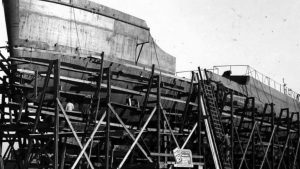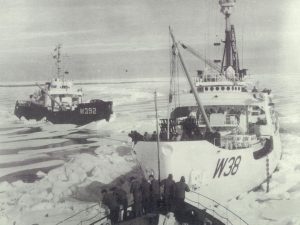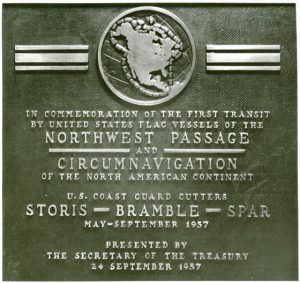After Task Force Five completed its mission Bramble returned to Miami to take up her duties as an AtoN tender and SAR platform. These duties included assisting in the evacuations of Charleston, South Carolina, and Savannah, Georgia, under the threat of Hurricane Gracie.
In August 1962 the well-traveled buoy tender, with service in the Pacific Ocean, Atlantic Ocean, Arctic Ocean, and Caribbean Sea, returned home to the Great Lakes. She took up station in Detroit, Michigan, and went to work as an AtoN tender and icebreaker.
The Duluth shipyards originally built the 180s to carry out icebreaking duties. Their reinforced hulls and notched bows allowed them to power through ice up to several inches thick. On occasion, however, the ice was not the danger; instead it was the vessel they were helping that posed a threat. Bramble was breaking ice for the commercial vessel Robert S. McNamara when the following vessel got too close and collided with Bramble’s stern. The buoy tender survived without serious damage and it appears this was the only collision in which Bramble was involved.
Bramble underwent a Major Renovation at the Curtis Bay yard in 1974. The repairs included an overhaul of her engines, installation of a new hydraulic boom, and habitability improvements. After the yard period Bramble was assigned to Port Huron, Michigan. Bramble has operated out of Port Huron for the last seventeen years except for patrols in the Caribbean during the winters of 1986-1987 and 1997. During the 1997 trip to the Caribbean Bramble participated in training programs involving the marine police of ten island nations and joint operations with Venezuelan maritime forces.
One of the last 180s in U.S. service as a buoy tender, Bramble was decommissioned on May 22, 2003. Where she has been part of the Port Huron museum until its closing in 2011.
Purchased in 2018 by the current owner, with ongoing maintenance and repairs planned to be completed prior to departing from Miami on the 26th May 2019 to once again circumnavigate the United States, taking the North West passage, retracing the first ever passage completed in 1957 by Task Force Five.
Deployments:
Great Lakes ’43-’44
San Pedro, CA ’44-’45
Juneau, AK ’45-’46
San Francisco, CA ’46
Hawaii ’46-’47
San Francisco, CA ’47-’49
San Juan, PR ’49-’53
Miami Beach, FL ’53-’62
Detroit, MI ’62-’74
Port Huron, MN ’74-2003
Port Huron, MN – Museum – 2003-2011 (Museum closed in 2011 due to lack of funding)
Port Huron, MN – Private Ownership – Robert B Klingler – 2013-2018
Port Huron, MN – Private Ownership – Tom Clarke – 2018-2019
Mobile, AL / Houma, LA – Private Ownership – Modern American Recycling Center – 2019 – Present
 Bramble — Iris Class
Bramble — Iris Class
 The purpose of the voyage was to find out if the Northwest Passage was a feasible supply route between the Atlantic and Pacific, one that the U.S. military could use in times of war when enemy action might close other shipping routes. Military planners had especially high hopes for the Northwest Passage as a resupply route for the Defensive Early Warning (DEW) line. This line of radar stations guarded against surprise Soviet attack via the Arctic. Though Task Force Five completed the voyage without serious mishap, the difficulty of the journey and the conditions encountered by the vessels led military planners to abandon the idea of establishing shipping lanes across the top of the continent.
The purpose of the voyage was to find out if the Northwest Passage was a feasible supply route between the Atlantic and Pacific, one that the U.S. military could use in times of war when enemy action might close other shipping routes. Military planners had especially high hopes for the Northwest Passage as a resupply route for the Defensive Early Warning (DEW) line. This line of radar stations guarded against surprise Soviet attack via the Arctic. Though Task Force Five completed the voyage without serious mishap, the difficulty of the journey and the conditions encountered by the vessels led military planners to abandon the idea of establishing shipping lanes across the top of the continent.